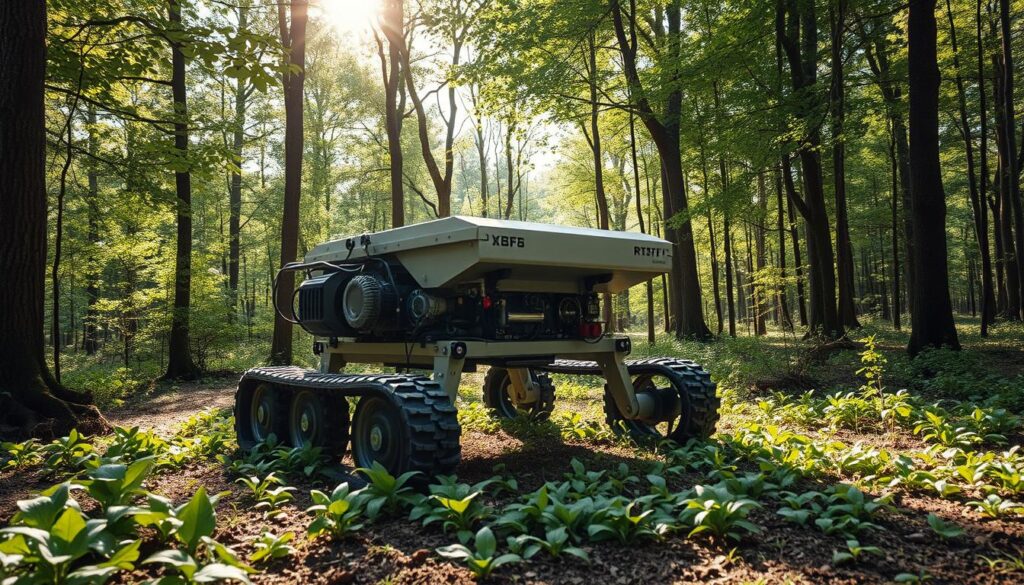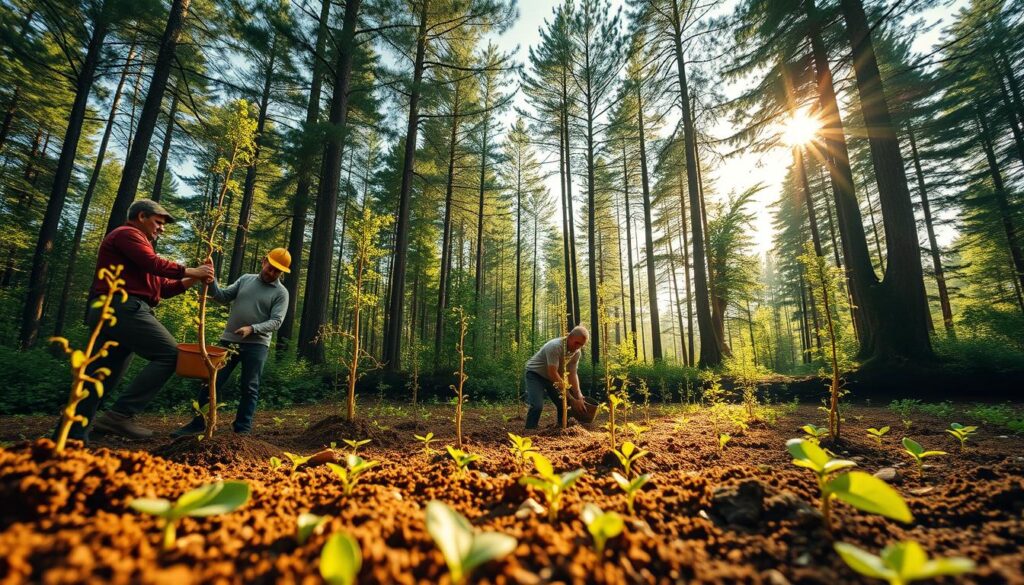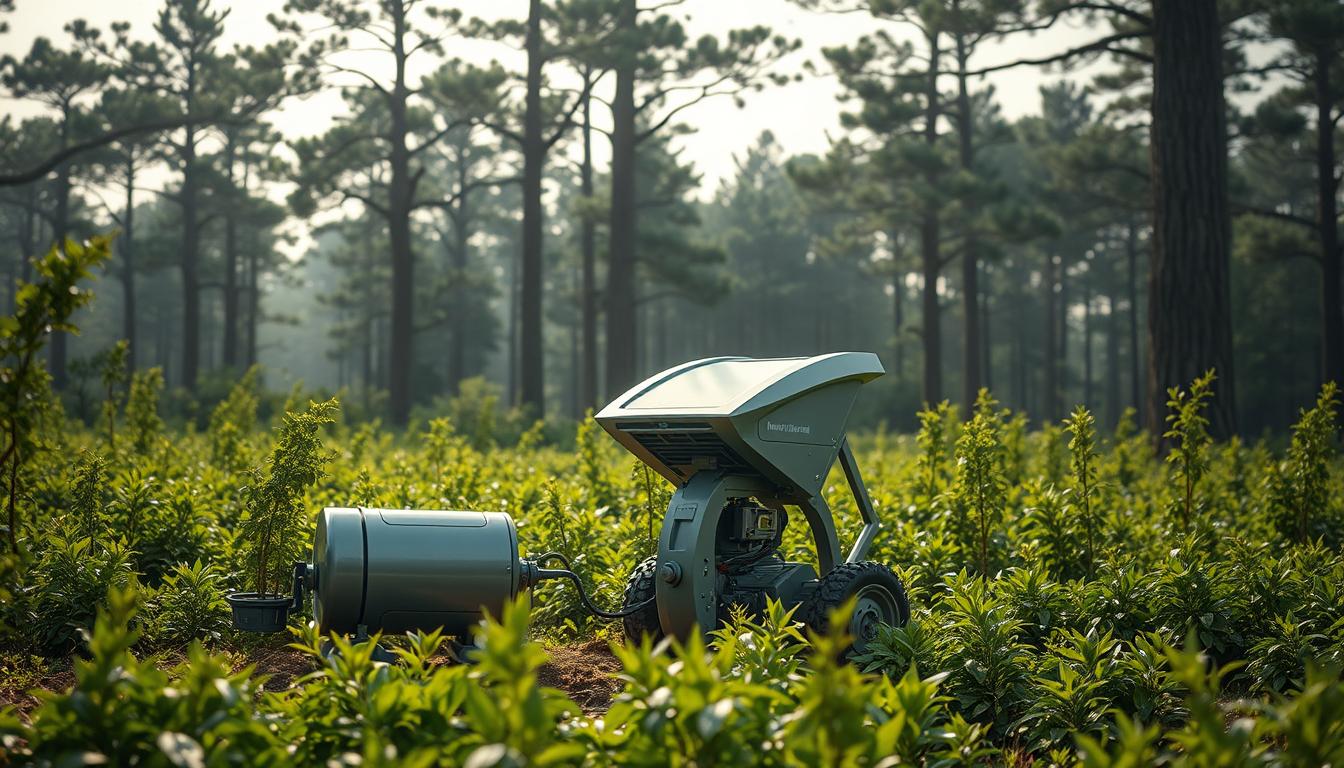Imagine standing on a barren landscape, watching technology turn empty ground into a vibrant forest. Tree seeder technology is changing how we reforest, offering hope against massive deforestation.
Forests cover only 31% of Earth’s land and lose about 10 million hectares yearly. New seed planting methods are key. Tree seeder technologies are quick and efficient ways to restore our planet’s green lungs.
The United Nations has called for a ‘Decade on Ecosystem Restoration’. Modern tree seeder techniques do more than plant trees. They are a complete strategy against climate change, preserving biodiversity, and regenerating ecosystems.
Table of Contents
Understanding Modern Reforestation Challenges
The world is fighting hard against environmental damage, with a focus on reforestation technology. Sadly, forests are disappearing fast, with about 10 million hectares lost each year since 2000.
Global Deforestation Statistics
Here’s a look at the current state of our planet:
- Forests cover just 31% of Earth’s land area
- Deforestation threatens biodiversity and climate stability
- Reforestation equipment has become crucial in combating forest loss
“We are the first generation to feel the effect of climate change and the last generation who can do something about it.” – United Nations Environment Programme
Impact on Climate Change
Forests are key in fighting climate change by absorbing carbon dioxide. The United Nations has called for a ‘Decade on Ecosystem Restoration’ from 2021 to 2030. This shows how urgent it is to use new reforestation technology.
Economic Implications
Deforestation has big economic costs. New reforestation tools can cut planting costs by up to 70% compared to manual methods. Tools like robotic seeders can plant up to 10,000 trees a day. This makes it easier to restore large areas of forest.
| Reforestation Method | Trees Planted per Day | Cost Efficiency |
|---|---|---|
| Manual Planting | 1,000-2,000 | High Labor Costs |
| Robotic Seeding | 10,000 | 70% Cost Reduction |
By using the latest in reforestation technology, we can change how we restore the environment. This will help us build a more sustainable future.
Evolution of Tree Planting Methods
Tree planting has changed a lot over time. It used to be done by hand, which was slow and hard work. Now, we have new tech that makes planting trees fast and easy.
Several things have led to these changes:
- Growing global demand for rapid forest restoration
- Increasing environmental challenges
- Technological advancements in agriculture and conservation
Before, people could plant about 1,000 to 2,000 trees a day. Now, robots can plant up to 10,000 trees every day. This is a huge step forward in how we plant trees.
New tech has brought big changes to how we plant trees:
- Precision drone planting
- Robotic ground-based seeding
- Automated mapping and distribution systems
- AI-powered seed selection techniques
These new methods make planting trees faster, more accurate, and better for the environment. The future of planting trees looks very promising, with more tech and efficiency.
Tree Seeder Technology Revolution
The world of forestry tools is changing fast with new tech. This change is making tree planting more precise and efficient. Advanced robotic and digital solutions are leading this shift.
New technologies are changing how we plant trees. They offer better ways to spread seeds and fix ecosystems. These tools help solve big environmental problems quickly and accurately.
Automated Seeding Systems
Modern automated seeding systems are a big step forward. They can plant trees at incredible speeds:
- Robotic systems can plant up to 10,000 trees per day
- Autonomous drones can plant 100,000 trees daily
- They cut costs by up to 70% compared to manual planting
Precision Agriculture Integration
These tools use advanced tech to plant trees better. They use precision agriculture to choose the best spots for planting. Digital sensors and AI help place seeds for the best chance of survival.
| Technology | Planting Capacity | Efficiency Improvement |
|---|---|---|
| Robotic Seeders | 10,000 trees/day | 70% cost reduction |
| Autonomous Drones | 100,000 trees/day | 90% terrain coverage |
Digital Mapping Capabilities
Digital mapping is making tree planting even better. It uses satellite images, GPS, and AI to find the best places to plant. It also checks how trees are growing and the health of the ecosystem.
These new tools are making tree planting faster and smarter. They turn a hard job into a high-tech effort that can help fix our planet faster.
The Muvuca Method: Nature-Inspired Seeding
The Muvuca method is a new way to grow forests that are inspired by nature. It uses a mix of native plant species to mimic a natural forest. This method is a big change from the old ways of planting trees.
This method is different because it doesn’t plant trees one at a time. Instead, it mixes seeds from many native species and plants them all at once. This creates a natural competition that helps the forest grow.
Studies show that the Muvuca method works well. In Brazil, it has helped restore 11,000 hectares of forests. This has led to about 33 million new trees and 80,000 tons of carbon dioxide being removed from the air each year. It also makes planting trees much faster than before.
“Nature doesn’t plant trees one by one – it creates entire ecosystems simultaneously.”
The Muvuca method’s success comes from creating a self-organizing forest ecosystem. It uses seeds from different types of plants to ensure the forest grows strong and diverse. This way, the forest can regenerate itself naturally.
Learning about the Muvuca method shows us that planting seeds can be both scientific and natural. It’s a way to grow forests that’s in line with how nature works.
Drone-Based Seeding Solutions
Reforestation technology has seen a big leap forward with drone-based tree seeders. These drones are changing how we bring back forests. They can reach places that were hard or impossible to plant trees before.
Autonomous drones are a big step forward in planting trees. They can plant up to 100,000 trees per day. This is much faster than humans can. It’s helping solve big problems in reforestation around the world.
Aerial Deployment Advantages
Drone technology brings many benefits to reforestation:
- Access to remote and dangerous terrains
- Precise seed pod deployment
- Reduced human labor costs
- Rapid large-scale planting capabilities
Advanced Terrain Mapping
Modern tree seeder drones use advanced mapping to find the best places to plant. They use GPS and topographical scanning to check soil, terrain, and ecosystem needs. This makes planting more accurate and effective.
Seed Pod Innovation
New seed pods for drones have special nutrients and protection. These pods help seeds survive and grow better. They create a good environment for seeds to start growing, helping reforestation efforts succeed.
Drone technology is not just changing how we plant trees—it’s revolutionizing our approach to environmental restoration.
Robotic Ground-Based Seeders

The future of reforestation is here with advanced robotic seeders. These tools are changing how we bring back forests. They are a big step forward in planting technology, ready to make a big difference in restoring our environment.
Today’s reforestation equipment includes smart robots that can handle tough terrains with great accuracy. The Planting Revolution, a Canadian company, has created a robot that can plant up to 10,000 trees a day. This is a huge leap from the old ways of planting trees by hand.
- Planting capacity of up to 10,000 trees per day
- Precision navigation across diverse landscapes
- Minimal environmental disruption
- Reduced labor costs
These robotic seeders use the latest tech to make sure trees are planted right. They check the soil, moisture, and terrain before planting. This ensures each seed gets the best chance to grow.
“Robotic seeders are not just machines; they’re hope in mechanical form.” – Environmental Technology Expert
With advanced sensors and AI, these tools speed up reforestation. They cut planting costs by up to 70% compared to manual planting. This makes it easier and cheaper to restore big areas of forest.
AI-Powered Seed Distribution Systems
Artificial intelligence is changing how we plant trees. It’s making reforestation smarter and more precise. AI helps us find the best places to plant trees in different landscapes.
Machine Learning Applications in Seed Distribution
Today’s AI systems can read complex environmental data with great detail. They look at important things like:
- Soil composition
- Moisture levels
- Temperature variations
- Ecosystem biodiversity
Predictive Analytics for Optimal Planting
AI can predict the best ways to spread seeds. It uses lots of data to suggest planting methods that help trees grow well.
Real-time Monitoring Solutions
AI keeps an eye on trees as they grow. Robots track their health and help make sure they thrive.
AI is turning seed dispersal into a smart, data-driven process.
AI is key in solving big reforestation problems. It gives us hope for a greener future.
Sustainable Seed Management Practices

Sustainable forestry needs new ways to manage seeds. These methods can change local areas and help the economy. Your seed planting can make a big difference.
The Redário initiative shows how seed networks can change things. It has 275 native species and 1,200 people involved. They’ve made over 2.5 million Brazilian reais for seed collectors. This supports restoration in many Brazilian biomes, showing the value of smart seed management.
- Create diverse seed collection networks
- Develop local economic opportunities
- Support ecosystem restoration
- Generate income for rural communities
Sustainable seed planting is more than just planting trees. It’s about using complex strategies. These strategies include:
- Species diversity
- Local ecological conditions
- Community engagement
- Economic sustainability
| Seed Network Metric | Impact |
|---|---|
| Native Species Traded | 275 species |
| Restoration Projects | 95 projects |
| Economic Generation | 2.5 million Brazilian reais |
| Participants | 1,200 community members |
By focusing on sustainable forestry, you help the planet and local economies. The future of reforestation is in working together and using community-driven seed management.
Cost-Effectiveness and Scalability
Reforestation has entered a new era of technology. Modern tree planting methods are changing how we restore the environment. This makes it more affordable than ever.
New technologies have changed the cost of tree planting. Automated systems can cut costs by up to 70% compared to manual methods.
Economic Benefits Analysis
Investing in advanced reforestation tech can bring big returns. The main economic benefits are:
- Dramatically reduced labor costs
- Higher planting efficiency
- Increased tree survival rates
- Scalable deployment across different terrains
Implementation Strategies
Successful tree planting needs a good plan. Here are some strategies to consider:
- Conduct comprehensive site assessments
- Select appropriate technological solutions
- Train local teams in new planting techniques
- Develop sustainable funding models
Innovative technologies like drone-based seeding and robotic planters are making reforestation more affordable. They turn a costly task into a smart investment.
Environmental Impact Assessment
Tree seeding technologies are changing how we protect the environment. The United Nations has called for a ‘Decade on Ecosystem Restoration’. This shows how important new ways to care for forests are.
These new methods don’t just plant trees. They focus on keeping ecosystems healthy. Robotic and drone-based systems can now plant trees in hard-to-reach places without harming the plants already there.
- Minimally invasive planting techniques
- Precision targeting of restoration areas
- Reduced soil and ecosystem disturbance
- Enhanced biodiversity preservation
These technologies help restore nature fast and capture carbon. Drone seeding can plant up to 100,000 trees a day. This speeds up the growth of forests. It also brings in different native plants to make ecosystems stronger.
| Technology | Daily Planting Capacity | Ecosystem Impact |
|---|---|---|
| Manual Planting | 1,000-2,000 trees | High ground disturbance |
| Drone Seeding | 100,000 trees | Minimal ecosystem disruption |
| Robotic Planting | 10,000 trees | Precision targeting |
Forests cover about 31% of Earth and lose 10 million hectares each year. These advanced tools are key to saving our planet.
Conclusion
Tree seeder technologies are changing how we restore forests. The Muvuca technique is leading the way, showing great results. We’ve seen 11,000 hectares restored and about 33 million new trees growing in Brazil’s different biomes.
The future of reforestation is bright with new tech and green practices. Automated systems can plant up to 10,000 trees a day. This not only speeds up forest growth but also helps local communities, especially women in seed businesses.
You play a big part in helping restore forests. By supporting these new planting methods, you help the environment. Projects like ‘Caminhos da Semente’ show how reforestation can fight climate change.
With 10 million hectares of forest lost each year, we need these technologies more than ever. We must keep investing in them and work together to save our forests.
FAQ
What is a tree seeder and why is it important?
A tree seeder is a high-tech tool for planting trees quickly and in large numbers. It helps fight global deforestation and climate change. These devices can spread seeds over big areas fast, making reforestation work much quicker than old methods.
How do modern tree-seeding technologies differ from traditional planting methods?
Today’s tree seeding tech uses advanced tools like drones and AI. It’s faster and more precise than old ways. This tech can cover lots of ground quickly and pick the best spots to plant trees, making more trees grow.
What is the Muvuca method of seed planting?
The Muvuca method is a smart way to plant seeds that copy how forests grow naturally. It spreads a mix of seeds over a big area. Then, nature picks which seeds will grow, helping trees grow in a variety of ways and saving money.
How are drones being used in tree-seeding operations?
Drones are changing tree seeding by planting seeds in places that are hard or dangerous to reach. They use maps to find the best spots and carry special seed pods. This makes planting seeds much faster than before.
What role does artificial intelligence play in modern reforestation?
AI is key in reforestation by looking at data, predicting the best times to plant, and watching over the trees. It uses learning to make planting more successful and saves resources by giving smart advice.
Are these advanced tree-seeding technologies cost-effective?
At first, these new tree-seeding tools cost a lot. But they save money in the long run. They cut down on labor costs, plant more trees, and help big reforestation projects. These projects can also make money by helping the environment and capturing carbon.
How do modern tree-seeding methods impact local ecosystems?
These new tree seeding methods help restore ecosystems, not just plant trees. They use different seeds and smart planting to protect the soil and boost biodiversity. This makes forests stronger and more diverse.
What challenges remain in tree seeding technology?
Even with big steps forward, there are still hurdles. Some of them are improving seed pods, better AI, making tech cheaper, and finding solutions for different places. Scientists and engineers continue to work to solve these problems.

